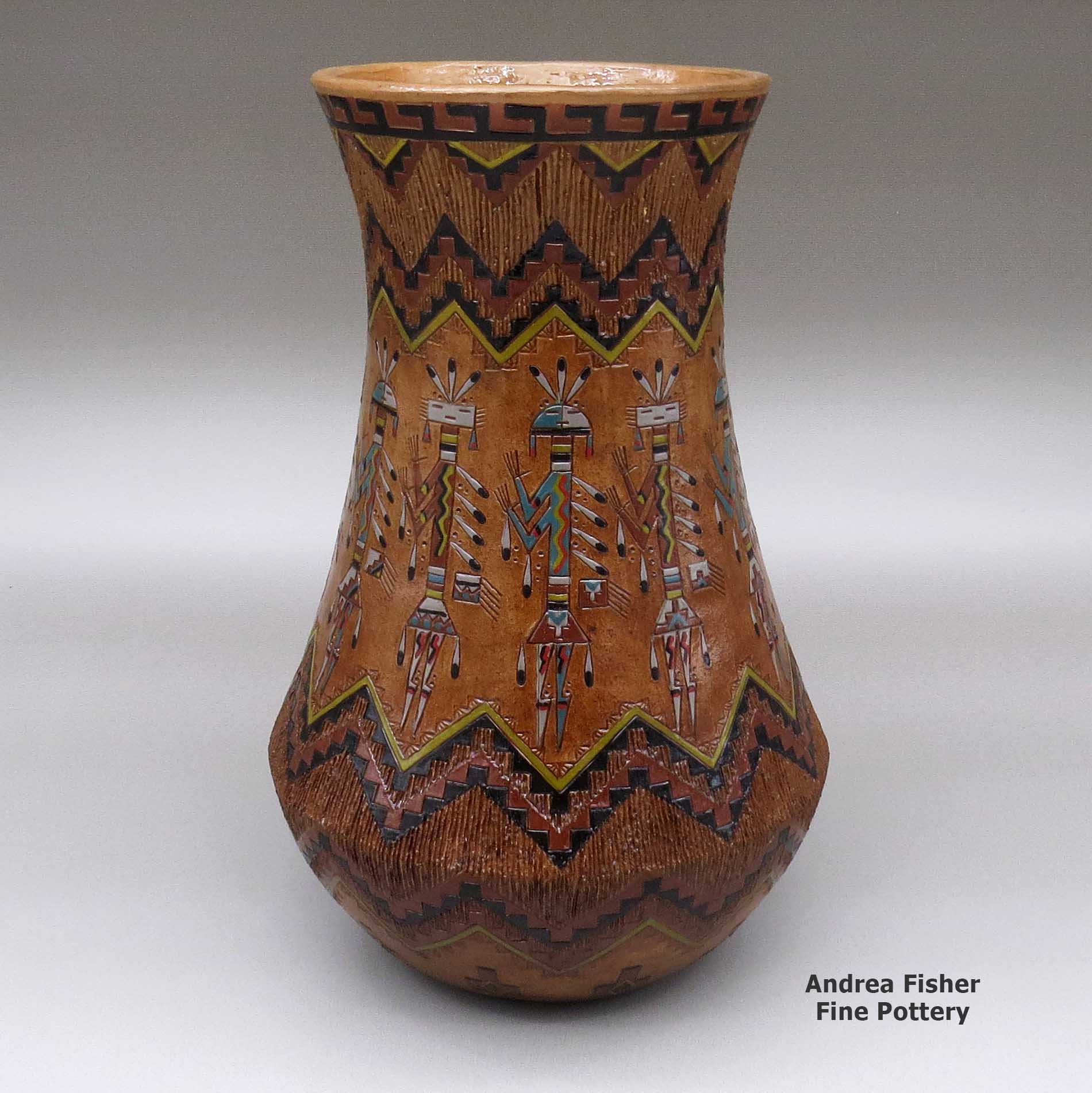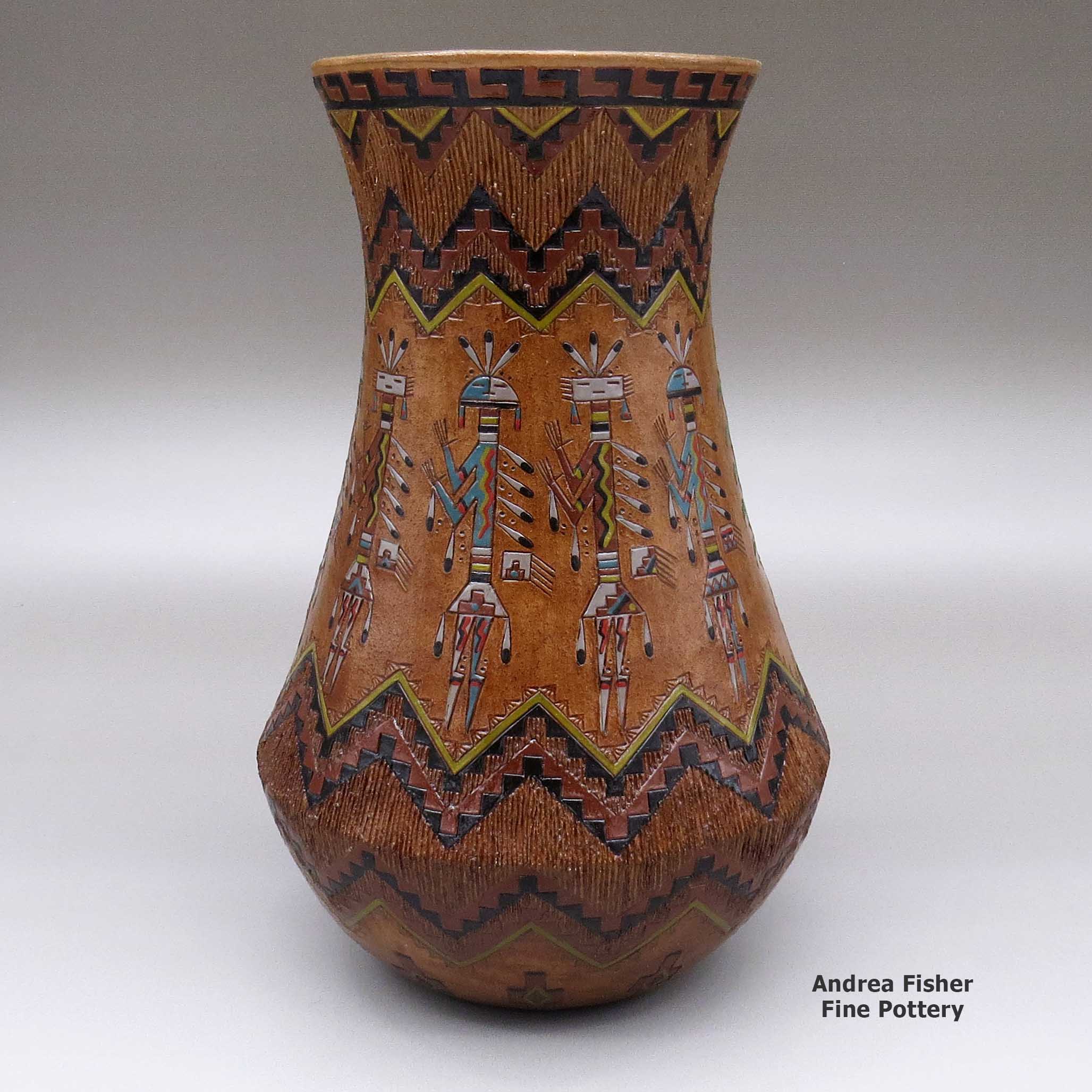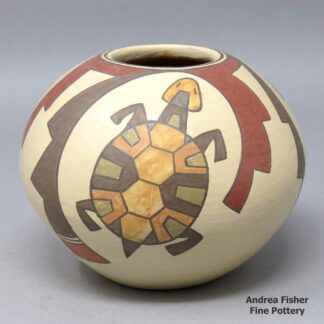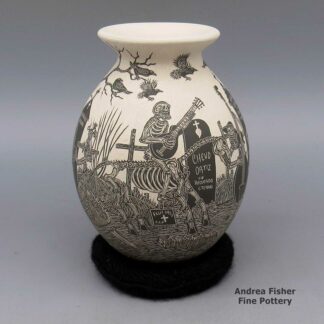| Dimensions | 7.75 × 7.75 × 12.5 in |
|---|---|
| Condition of Piece | Excellent |
| Date Born | 2023 |
| Signature | NAY JDY, with hallmark |
Nancy Yazzie, zznv3a191, Polychrome jar with pine pitch coating, and a yei, cornstalk, and Dineh carpet design
$995.00
A polychrome jar with a flared opening, a pine pitch coating, and a sgraffito-and-painted yei, cornstalk and Dineh carpet design
In stock
Brand
Yazzie, Nancy
 Born in February 1973, Nancy Yazzie is a Dineh potter who's been producing pottery for the market since 2001. Well-known Dineh potters Lorraine Williams-Yazzie and Irene White are members of her family but Nancy says she learned the traditional art mostly on her own with some pointers from Calvin Yazzie, her brother-in-law.
Born in February 1973, Nancy Yazzie is a Dineh potter who's been producing pottery for the market since 2001. Well-known Dineh potters Lorraine Williams-Yazzie and Irene White are members of her family but Nancy says she learned the traditional art mostly on her own with some pointers from Calvin Yazzie, her brother-in-law.These days Nancy mostly works together with her husband, Jackson Yazzie, producing Dineh-style pottery: brown clay from the Black Mesa area decorated with either Dineh country scenes or Dineh carpet designs. In Nancy's case, she likes to make tall necked vases (often with square necks) and decorate them with multi-colored Yei (the Yeibichai are Dineh spirit-deities) and geometric designs, many from the catalog of Dineh carpet designs.
Nancy has participated in juried competitions at the Edge of the Cedars Museum in Blanding, UT (where she's gone home with at least one First Place ribbon), the Navajo Nation Fair in Window Rock (earning First and Second Place ribbons and Best of Show) and at the Cave Creek Museum in Cave Creek, AZ.
We asked Nancy where she finds the time (she and Jackson have 4 children still at home) and she sighed, saying, "Making pottery is my peace, my meditation."
We asked where she finds her inspiration and her eyes twinkled: "From my husband and from our tribal traditions."
Our final question was what would she like the world to know about her other than about her pottery. Her eyes twinkled even more as she replied, "There's nothing like being surrounded by wilderness. I just love it."
About the Dineh
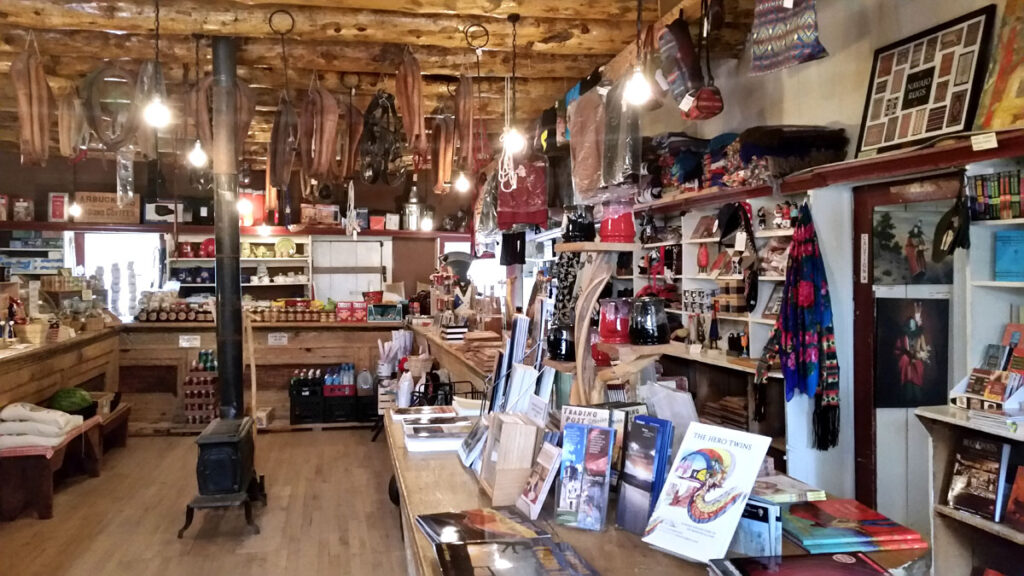

Historical and archaeological evidence points to the Dineh entering the Southwest around 1400 AD. Their oral history still contains stories of that migration as the journey began in eastern Alaska and northwestern Canada centuries after their ancestors made the journey across the Bering Land Bridge from central Asia about 10,000 years ago. They were primarily hunter-gatherers until they came into contact with the Pueblo peoples and learned the basics of survival in this drier climate. Dineh oral history points to a long relationship between the Dineh and the Ancestral Puebloans as they learned from and traded with each other.
When the Spanish first arrived, the Dineh occupied much of the area between the San Francisco Peaks (in Arizona), Hesperus Mountain and Blanca Peak (in Colorado) and Mount Taylor (in New Mexico). Spanish records indicate they traded bison meat, hides and stone to the Puebloans in exchange for maize and woven cotton goods. It was the Spanish who brought sheep to the New World and the Dineh took to sheep-herding quickly with sheep becoming a form of currency and sign of wealth.
When the Americans arrived in 1846, things began to change. The first fifteen years were marked by broken treaties and increasing raids and animosities on both sides. Finally, Brigadier General James H. Carleton ordered Colonel Kit Carson to round up the Dineh and transport them to Bosque Redondo in eastern New Mexico for internment. Carson succeeded only by engaging in a scorched earth campaign in which his troops swept through Dineh country killing anyone carrying a weapon and destroying any crops, livestock and dwellings they found. Facing starvation and death, the last band of Dineh surrendered at Canyon de Chelly.
Carson's campaign then led straight into "the Long Walk" to Bosque Redondo, a 300-mile trek during which at least 10% of the people died along the way. At Bosque Redondo they discovered the government had not allocated an adequate supply of water, livestock, provisions or firewood to support the 4,000-5,000 Dineh interned there. The Army also did little to protect the Dineh from raids by other tribes or by Anglo citizens. The failure was such that the Federal government and the Dineh negotiated a treaty that allowed the people to return to a reservation that was only a shadow of their former territory little more than a couple years after they had left. However, succeeding years have seen additions to the reservation until today it is the largest Native American Reservation in the 48 contiguous states.
Large deposits of uranium were discovered on the Dineh Nation after World War II but the mining that followed ignored basic environmental protection for the workers, waterways and land. The Dineh have made claims of high rates of cancer and lung disease from the environmental contamination but the Federal government has yet to offer comprehensive compensation.


The location of the Dineh Nation
For more info:
Navajo Nation at Wikipedia
Diné people at Wikipedia
Navajo Nation Government official website
Photos are our own. All rights reserved.
About Dineh Pottery
As a nomadic people, pottery didn't make much sense to the Dineh as they made the journey south from the northwestern corner of North America. When they came up against the Ancestral Puebloans they settled into a more sedentary lifestyle. The puebloans taught them much about how to survive in this climate on this landscape. That included the making of pottery for utilitarian purposes. That suited the Dineh religious authorities and as more and more Anglo settlers came into the area, they developed a business selling utilitarian wares to them. That essentially ended when the United States came into ownership of the land and American traders arrived with their relatively inexpensive and long-lasting enameled and cast iron cookware. Then pottery production scaled back to just ceremonial pieces being made.
Rose Williams learned how to make pottery from her aunt, Grace Barlow. Rose learned how to make basic brown pottery in utilitarian shapes. She only allowed herself the occasional rope biyo' for decoration, relying more on how she stacked her wood in the firing to make the fire clouds she wanted. Rose liked to make large brown jars which were often used to make drums. Living to be 99 years old and making pottery almost until she passed, Rose taught many people how to make pottery.
Grace Barlow also taught her granddaughter, Betty Manygoats. Betty in turn, taught all her children how to make pottery. Only Elizabeth has made a living at it.
Other modern potters on the reservation have usually learned how to make pottery the traditional way in the classrooms at the Institute for American Indian Arts.
About Jars
The jar is a basic utilitarian shape, a container generally for cooking food, storing grain or for carrying and storing water. The jar's outer surface is a canvas where potters have been expressing their religious visions and stories for centuries.
In Sinagua pueblos (in northern Arizona), the people made very large jars and buried them up to their openings in the floors of the hidden-most rooms in their pueblo. They kept those jars filled with water but also kept smaller jars of meat and other perishables inside those jars in the water. It's a form of refrigeration still in use among indigenous people around the world.
Where bowls tend to be low, wide and with large openings, jars tend to be more globular: taller, less wide and with smaller openings.
For a potter looking at decorating her piece, bowls are often decorated inside and out while most jars are decorated only on the outside. Jars have a natural continuity to their design surface where bowls have a natural break at the rim, effectively yielding two design surfaces on which separate or complimentary stories can be told.
Before the mid-1800s, storage jars tended to be quite large. Cooking jars and water jars varied in size depending on how many people they were designed to serve. Then came American traders with enameled metal cookware, ceramic dishes and metal eating utensils...Some pueblos embraced those traders immediately while others took several generations to let them and their innovations in. Either way, opening those doors led to the virtual collapse of utilitarian pottery-making in most pueblos by the early 1900s.
In the 1920s there was a marked shift away from the machinations of individual traders and more toward marketing Native American pottery as an artform. Maria Martinez was becoming known through her exhibitions at various major industrial fairs around the country and Nampeyo of Hano was demonstrating her art for the Fred Harvey Company at the Grand Canyon. The first few years of the Santa Fe Indian Market helped to solidify that movement and propel it forward. It took another couple generations of artists to open other venues for their art across the country and turn Native American art into the phenomenon it has become.
Today's jars are artwork, not at all for utilitarian purposes, and their shapes, sizes and decorations have evolved to reflect that shift.
About Dineh Carpet Designs
The Dineh people are very strict about the usage of many of their images and designs, especially on items for sale to the public. It's hard to take back a spiritual design once it has been set free in the world. It's hard to be forgiven for doing that, too. So Dineh pottery artists tend to stick to using designs that have been pre-approved for transmission into the outside world. The vast majority of those designs have been woven into Dineh carpets for more than a hundred years now. That allows the potters a vast catalog of simple, easily repeatable designs to work with, should they choose to do more than just offer simple biyo' designs on fire-clouded brown pottery.
In that catalog of carpet designs are various approved designs for yeibichai, Dineh spiritual entities. Those designs are often used by Nancy Yazzie and the McKelvey family.
Ida Sahmie went a bit further: she uses designs depicting Day Chant and Night Chant Dancers. However, she feels the need to have the appropriate dance done for her before she sits down to paint those. She feels that's how she wards off evil spirits and earns permission to paint those images. Christian Dineh potters don't go through that, but they don't use those images either.
